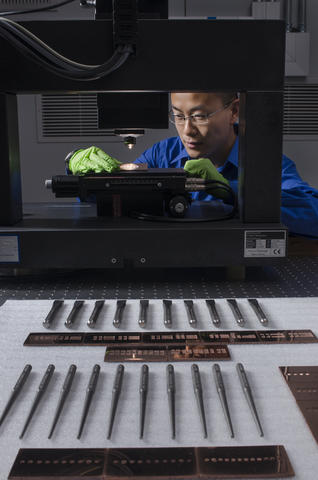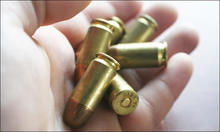Firearms and Toolmarks

NIST researcher Alan Zheng uses a 3D disc scanning confocal microscope to examine a chisel toolmark.
Goal: To build a scientific infrastructure for objective forensic firearm and toolmark analysis with a rigorous evaluation of uncertainty to quantify the strength of the evidence for expert testimony in court proceedings.
What is Firearm and Toolmark Analysis?
When a firearm is fired it leaves marks on the bullet and cartridge case. Forensic firearm and toolmark examiners compare these marks to evaluate whether a bullet or cartridge case recovered at a crime scene was fired by a particular firearm. A similar comparison is performed for marks left by other tools, such as screwdrivers, pry bars, and bolt cutters.
Why is NIST involved in Firearms and Toolmarks?
- The comparison of toolmarks is currently a subjective process that relies on the skill and expertise of the examiner. NIST is working with the forensic community to augment an examiner’s testimony with objective measures for toolmark similarity and the strength of the evidence.
- Firearm and toolmark analysis are transitioning from the use of comparison microscopes to the acquisition and comparison of three dimensional (3D) toolmark topography images. This new technology requires standards and procedures to ensure measurement data interoperability and traceability.
What is NIST doing?
- Developing standards, reference artifacts, and procedures for measurement quality assurance and interoperability
- Building research and reference databases of toolmarks for method development and statistical evaluation of the strength of the evidence
- Developing objective metrics and algorithms for evaluating the similarity of toolmarks
- Developing statistical models and procedures to quantify the strength of the evidence.
Associated Links
- Surface And Interface Metrology Group
- 2022 Firearm And Toolmarks Policy And Practice Forum
- NIST Ballistics Toolmark Research Database
- How Good a Match is It? Putting Statistics into Forensic Firearms Identification
- OSAC
- Center of Excellence (CSAFE)
News

Two New Forensic Firearm Examination Standards Added to the OSAC Registry of Approved Standards
Registry notches its 100th standard, marking a milestone for the forensic science organization.
Contacts
Forensic Science Research Firearms and Toolmarks Focus Area Lead
-
(301) 975-6474
Subject matter expert
Measurement quality assurance
-
(301) 975-4274
-
(301) 975-5102
-
(301) 975-4095
Research and reference databases
-
(301) 975-6474
-
(301) 975-4095
Algorithms and objective comparison
-
(301) 975-6474
Strength of the evidence
-
(301) 975-4095
Statistical support
-
(301) 975-2843

